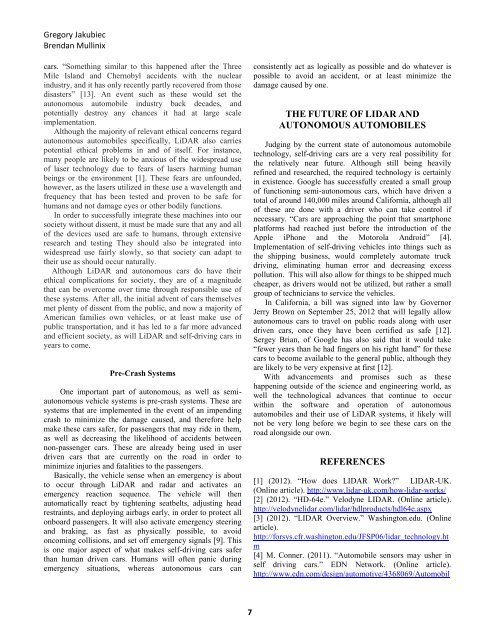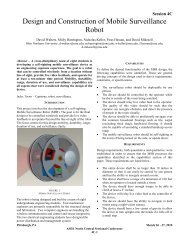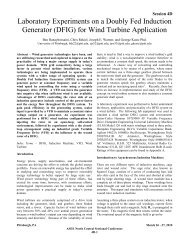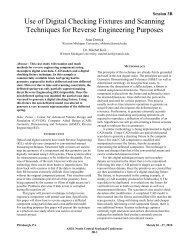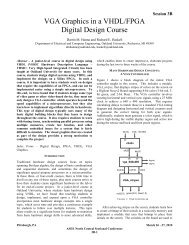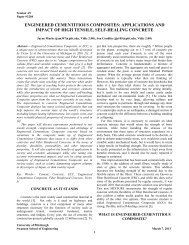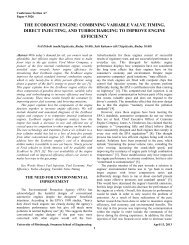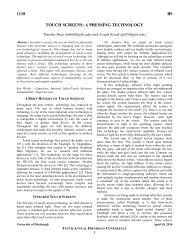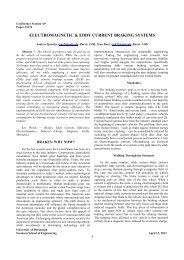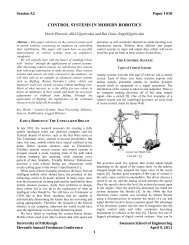the use of lidar technology in autonomous cruise control systems for ...
the use of lidar technology in autonomous cruise control systems for ...
the use of lidar technology in autonomous cruise control systems for ...
Create successful ePaper yourself
Turn your PDF publications into a flip-book with our unique Google optimized e-Paper software.
Gregory JakubiecBrendan Mull<strong>in</strong>ixcars. “Someth<strong>in</strong>g similar to this happened after <strong>the</strong> ThreeMile Island and Chernobyl accidents with <strong>the</strong> nuclear<strong>in</strong>dustry, and it has only recently partly recovered from thosedisasters” [13]. An event such as <strong>the</strong>se would set <strong>the</strong><strong>autonomous</strong> automobile <strong>in</strong>dustry back decades, andpotentially destroy any chances it had at large scaleimplementation.Although <strong>the</strong> majority <strong>of</strong> relevant ethical concerns regard<strong>autonomous</strong> automobiles specifically, LiDAR also carriespotential ethical problems <strong>in</strong> and <strong>of</strong> itself. For <strong>in</strong>stance,many people are likely to be anxious <strong>of</strong> <strong>the</strong> widespread <strong>use</strong><strong>of</strong> laser <strong>technology</strong> due to fears <strong>of</strong> lasers harm<strong>in</strong>g humanbe<strong>in</strong>gs or <strong>the</strong> environment [1]. These fears are unfounded,however, as <strong>the</strong> lasers utilized <strong>in</strong> <strong>the</strong>se <strong>use</strong> a wavelength andfrequency that has been tested and proven to be safe <strong>for</strong>humans and not damage eyes or o<strong>the</strong>r bodily functions.In order to successfully <strong>in</strong>tegrate <strong>the</strong>se mach<strong>in</strong>es <strong>in</strong>to oursociety without dissent, it must be made sure that any and all<strong>of</strong> <strong>the</strong> devices <strong>use</strong>d are safe to humans, through extensiveresearch and test<strong>in</strong>g They should also be <strong>in</strong>tegrated <strong>in</strong>towidespread <strong>use</strong> fairly slowly, so that society can adapt to<strong>the</strong>ir <strong>use</strong> as should occur naturally.Although LiDAR and <strong>autonomous</strong> cars do have <strong>the</strong>irethical complications <strong>for</strong> society, <strong>the</strong>y are <strong>of</strong> a magnitudethat can be overcome over time through responsible <strong>use</strong> <strong>of</strong><strong>the</strong>se <strong>systems</strong>. After all, <strong>the</strong> <strong>in</strong>itial advent <strong>of</strong> cars <strong>the</strong>mselvesmet plenty <strong>of</strong> dissent from <strong>the</strong> public, and now a majority <strong>of</strong>American families own vehicles, or at least make <strong>use</strong> <strong>of</strong>public transportation, and it has led to a far more advancedand efficient society, as will LiDAR and self-driv<strong>in</strong>g cars <strong>in</strong>years to come.Pre-Crash SystemsOne important part <strong>of</strong> <strong>autonomous</strong>, as well as semi<strong>autonomous</strong>vehicle <strong>systems</strong> is pre-crash <strong>systems</strong>. These are<strong>systems</strong> that are implemented <strong>in</strong> <strong>the</strong> event <strong>of</strong> an impend<strong>in</strong>gcrash to m<strong>in</strong>imize <strong>the</strong> damage ca<strong>use</strong>d, and <strong>the</strong>re<strong>for</strong>e helpmake <strong>the</strong>se cars safer, <strong>for</strong> passengers that may ride <strong>in</strong> <strong>the</strong>m,as well as decreas<strong>in</strong>g <strong>the</strong> likelihood <strong>of</strong> accidents betweennon-passenger cars. These are already be<strong>in</strong>g <strong>use</strong>d <strong>in</strong> <strong>use</strong>rdriven cars that are currently on <strong>the</strong> road <strong>in</strong> order tom<strong>in</strong>imize <strong>in</strong>juries and fatalities to <strong>the</strong> passengers.Basically, <strong>the</strong> vehicle sense when an emergency is aboutto occur through LiDAR and radar and activates anemergency reaction sequence. The vehicle will <strong>the</strong>nautomatically react by tighten<strong>in</strong>g seatbelts, adjust<strong>in</strong>g headrestra<strong>in</strong>ts, and deploy<strong>in</strong>g airbags early, <strong>in</strong> order to protect allonboard passengers. It will also activate emergency steer<strong>in</strong>gand brak<strong>in</strong>g, as fast as physically possible, to avoidoncom<strong>in</strong>g collisions, and set <strong>of</strong>f emergency signals [9]. Thisis one major aspect <strong>of</strong> what makes self-driv<strong>in</strong>g cars saferthan human driven cars. Humans will <strong>of</strong>ten panic dur<strong>in</strong>gemergency situations, whereas <strong>autonomous</strong> cars canconsistently act as logically as possible and do whatever ispossible to avoid an accident, or at least m<strong>in</strong>imize <strong>the</strong>damage ca<strong>use</strong>d by one.THE FUTURE OF LIDAR ANDAUTONOMOUS AUTOMOBILESJudg<strong>in</strong>g by <strong>the</strong> current state <strong>of</strong> <strong>autonomous</strong> automobile<strong>technology</strong>, self-driv<strong>in</strong>g cars are a very real possibility <strong>for</strong><strong>the</strong> relatively near future. Although still be<strong>in</strong>g heavilyref<strong>in</strong>ed and researched, <strong>the</strong> required <strong>technology</strong> is certa<strong>in</strong>ly<strong>in</strong> existence. Google has successfully created a small group<strong>of</strong> function<strong>in</strong>g semi-<strong>autonomous</strong> cars, which have driven atotal <strong>of</strong> around 140,000 miles around Cali<strong>for</strong>nia, although all<strong>of</strong> <strong>the</strong>se are done with a driver who can take <strong>control</strong> ifnecessary. “Cars are approach<strong>in</strong>g <strong>the</strong> po<strong>in</strong>t that smartphoneplat<strong>for</strong>ms had reached just be<strong>for</strong>e <strong>the</strong> <strong>in</strong>troduction <strong>of</strong> <strong>the</strong>Apple iPhone and <strong>the</strong> Motorola Android” [4].Implementation <strong>of</strong> self-driv<strong>in</strong>g vehicles <strong>in</strong>to th<strong>in</strong>gs such as<strong>the</strong> shipp<strong>in</strong>g bus<strong>in</strong>ess, would completely automate truckdriv<strong>in</strong>g, elim<strong>in</strong>at<strong>in</strong>g human error and decreas<strong>in</strong>g excesspollution. This will also allow <strong>for</strong> th<strong>in</strong>gs to be shipped muchcheaper, as drivers would not be utilized, but ra<strong>the</strong>r a smallgroup <strong>of</strong> technicians to service <strong>the</strong> vehicles.In Cali<strong>for</strong>nia, a bill was signed <strong>in</strong>to law by GovernorJerry Brown on September 25, 2012 that will legally allow<strong>autonomous</strong> cars to travel on public roads along with <strong>use</strong>rdriven cars, once <strong>the</strong>y have been certified as safe [12].Sergey Brian, <strong>of</strong> Google has also said that it would take“fewer years than he had f<strong>in</strong>gers on his right hand” <strong>for</strong> <strong>the</strong>secars to become available to <strong>the</strong> general public, although <strong>the</strong>yare likely to be very expensive at first [12].With advancements and promises such as <strong>the</strong>sehappen<strong>in</strong>g outside <strong>of</strong> <strong>the</strong> science and eng<strong>in</strong>eer<strong>in</strong>g world, aswell <strong>the</strong> technological advances that cont<strong>in</strong>ue to occurwith<strong>in</strong> <strong>the</strong> s<strong>of</strong>tware and operation <strong>of</strong> <strong>autonomous</strong>automobiles and <strong>the</strong>ir <strong>use</strong> <strong>of</strong> LiDAR <strong>systems</strong>, it likely willnot be very long be<strong>for</strong>e we beg<strong>in</strong> to see <strong>the</strong>se cars on <strong>the</strong>road alongside our own.REFERENCES[1] (2012). “How does LIDAR Work?” LIDAR-UK.(Onl<strong>in</strong>e article). http://www.<strong>lidar</strong>-uk.com/how-<strong>lidar</strong>-works/[2] (2012). “HD-64e.” Velodyne LIDAR. (Onl<strong>in</strong>e article).http://velodyne<strong>lidar</strong>.com/<strong>lidar</strong>/hdlproducts/hdl64e.aspx[3] (2012). “LIDAR Overview.” Wash<strong>in</strong>gton.edu. (Onl<strong>in</strong>earticle).http://<strong>for</strong>sys.cfr.wash<strong>in</strong>gton.edu/JFSP06/<strong>lidar</strong>_<strong>technology</strong>.htm[4] M. Conner. (2011). “Automobile sensors may usher <strong>in</strong>self driv<strong>in</strong>g cars.” EDN Network. (Onl<strong>in</strong>e article).http://www.edn.com/design/automotive/4368069/Automobil7


